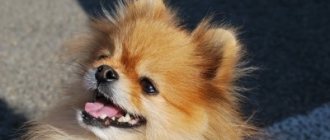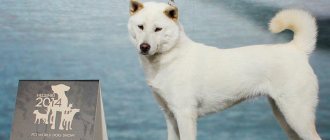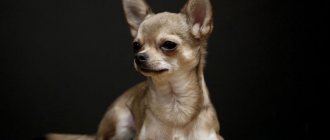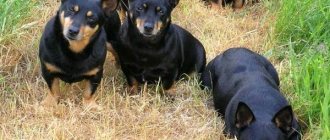Description
The history of the Chihuahua breed is very ancient, overgrown with legends and fables. Currently, these small dogs have conquered the whole world, gaining incredible popularity. Their small size makes it easy to take them on trips and trips, and living in city apartments with these pets is very convenient. But the point is not so much in the compactness and unpretentiousness of the content, but in devotion to the owner and affectionate character.
Based on the length of the coat, two exterior variations are distinguished. In the history of the breed, long-haired Chihuahuas are considered more ancient and purebred than representatives with smooth hair. However, more on this a little later.
The first happy owner of small Chihuahuas in Russia was Khrushchev himself, to whom puppies of this breed were brought from Cuba and given as a gift to Fidel Castro. A little later, two more babies were presented to him from Algeria.
All Chihuahua owners note the strong and courageous character of their pets, which does not correlate with their small size. The height at the withers of these dogs reaches only up to 23 cm with a weight of up to 2 kg. It is considered a behavioral feature of the character that the Chihuahua chooses one owner from the family and literally does not leave his person even one step. Experts recommend stopping such manifestations in order to prevent jealous-possessive behavior and aggression.
Description of the breed
The Chihuahua is the smallest dog breed. Perhaps this is also the only “natural” breed of toy dog for which breeding with a tendency to minimize parameters is not provided. Chihuahuas have a soft coat with a variety of colors: white, fawn, black-brown, etc. There is a smooth, or short-haired, variety, and there is also a long-haired one. Varieties are distinguished by the length of hair on the ears, chest, belly, legs and tail.
Today the breed standard approved in 2004 is in force. Height is not fixed by the standard; the main criterion is the weight of the dog. The ideal weight is from 1.5 kg to 3 kg. Weight is acceptable from 0.5 kg to 1.5 kg, but weight more than 3 kg is a reason for disqualification.
- The head is apple-shaped, well rounded, with flat cheeks, the muzzle is straight and short. The forehead is very steep. The presence of a fontanel is acceptable, but its absence is more preferable.
- The ears are well opened, erect and large. They are wide at the base and narrow towards the rounded tip. At rest, they are inclined towards the temples (angle approximately 45⁰).
- The eyes are very expressive, almost round, but not bulging, dark. Light color is acceptable, but not desirable. The Chihuahua's nose is relatively short, somewhat upturned. Lobe color - any.
- The bite in dogs can be scissor or straight, the cheekbones are only slightly pronounced. Undershot and overshot are serious faults.
- The Chihuahua's body is compact and well built. A square dog format is preferred. For females, a more extended format is acceptable than for males. The top line is flat, the bottom line indicates a taut belly. A loose belly is acceptable, but this is undesirable.
- The chest is voluminous, deep and wide, the lowest point reaches the elbows, the ribs are rounded. The Chihuahua's back is strong and short.
- The Chihuahua's forelimbs are quite long and straight when viewed from the front and side. The paws are oval, very small, the toes are spread apart but not splayed. The claws are convex and of moderate length. The pads are elastic and developed.
- The hind limbs are distinguished by well-developed muscles. The long bones are parallel to each other, the angles of the joints are in harmony with the angles of the forelimbs. The paws are small, neither cat nor hare, with spread toes. Well-developed pads are elastic. The claws are convex. Dewclaws are removed unless prohibited by country law.
- The Chihuahua's tail is distinguished by a high set and medium length. The tail is wide at the base and tapers towards the tip. When moving, the tail should be in a high bend, or curled into a half ring (the tip is directed towards the lower back). The position of the tail between the hind legs or below the line of the back is unacceptable. If the dog is long-haired, then there should be a plume of hair on the tail, forming a “sultan”.
- There are two types of Chihuahua coat, according to which two varieties of the breed are distinguished.
- The smooth-haired Chihuahua has short, close-lying hair that is longer than the undercoat. The hair is short on the face and ears, longer on the tail and neck. Not very thick hair on the belly and neck is acceptable; bald patches and completely hairless dogs are unacceptable.
- The long-haired Chihuahua has a silky, fine coat that is slightly wavy or smooth. There are featherings on the tail and paws, the inner surface of the hind and front legs, neck and ears. Excessive thickness of the undercoat is undesirable; shaggy long hair is unacceptable.
We advise you to read: African Basenji breed
All versions of occurrence
The history of the Chihuahua breed has several different versions of its origin. And some of them are simply fantastic. For example, there is an opinion about the alien origin of these dogs, which supposedly communicate with space through a fontanel that does not overgrow with age.
Briefly telling the history of the Chihuahua breed, one cannot help but note several less fantastic versions. According to one of them, these dogs were bred by the ancient Aztecs, according to another - by the Mayan civilization and the ancient Toltecs. The third version suggests that the smallest dog breed on the planet was bred in ancient Egypt. In addition, there are opinions about the origin of the described dogs in China, Japan and the island of Malta.
What do Chihuahuas eat?
Chihuahuas eat little: from 80 to 50 grams per kilogram of live weight for an adult dog per day. If you choose natural food, then remember that Chihuahua pork is contraindicated. Before giving it to your dog, boil other meat (veal, chicken), and then remove all the bones and fragments. A baby like a Chihuahua can choke on even a small bone.
We advise you to read: Weimaraner Dog Breed
How much to feed a Chihuahua?
You need to feed the baby like any other adult dog 2 times a day after a walk. If we are talking about a puppy, then it all depends on the age:
- From 3 to 6 weeks: approximately 6 times a day.
- From 3 to 6 months: 4 times a day.
- From 6 to 12 months: 2-3 times a day.
What foods are suitable for Chihuahuas?
These are the top 5 best foods according to experts:
- NOW Natural Fresh Small Breed Recipe – Canada, holistic, dry food for small breed dogs;
- Grandorf 4 Meat & Brown Rice – Belgium, holistic, hypoallergenic food for mini breeds;
- Almo Nature Holistic Adult Dog Small – Italy, super-premium;
- Purina Pro Plan Small & Mini Adult canine – USA, super premium;
- Bosch Mini Adult – Germany, super premium.
History of the origin of the breed in the territory of Indian tribes in Mexico
The most common version in the history of the Chihuahua breed talks about the appearance and development of these miniature dogs in the territory of modern Mexico. Most researchers are confident that the largest Mexican state of Chihuahua, located in the north of the country, bordering the American New Mexico and Texas, can be considered the ancestral home.
It was here in the border areas that traders from Mexico sold miniature dogs to tourists, who brought “living souvenirs” home to the United States, fascinated by the variety of types of these dogs (with varying lengths and coat colors).
History of the formation of the Chihuahua breed
Archaeological excavations have repeatedly confirmed the fact that Techichi (as Chihuahuas were originally called) is a very ancient breed that appeared on the territory of modern Mexico.
In many tombs and tombs of kings and pharaohs of antiquity, images of small dogs, which were then considered sacred, were found on the walls.
For example, the painting in the Temple of Montezuma, carved on stones, is almost directly related to the modern name of the breed - Chihuahua.
The remains of this image were found in 1850 in the Mexican state of Chihuahua , which later gave its name to the breed.
By the way, all over the world these decorative dogs are called exactly that – Chihuahuas.
In Russia, after some “simplifications,” the transcription of the word has undergone some changes.
Photo 2. Chihuahua “originally” from Mexico
The medieval Toltec tribe, who lived in Mexico at that time and gave the first name and, most likely, founded the roots of the breed, was supplanted by the Mayan and Aztec tribes.
During this period, not the best times came for the breed, because along with the sacrifices that were preserved, the meat of these dogs began to be eaten. Considered sacred, it was said to give strength to wars.
The situation for the Chihuahua did not change at all at the beginning of the 16th century, when a series of wars swept across Mexico during the conquest of America by the conquistadors.
Long and bloody massacres caused defeat to the local population and enormous damage to the population of this dog breed.
There is even a very funny semi-fantastic version that the ancestors of today's Chihuahuas hid from people in trees in the jungle.
Another version of the origin of this small breed generally states that the dogs came to us from outer space and carry the energy of the Universe, the connection with which is maintained by an open hole in the back of the head (by the way, Chihuahuas actually have it and are called the fontanelle, or Malera).
At the beginning of the 19th century, American travelers saw small dogs with large expressive eyes among the local population in Mexico and took them home as souvenirs.
The Mexicans immediately realized that this could become a source of income. They went into the forests and looked for these little dogs, and then sold them to the Americans at the border.
They were very willing to buy the little miracle, several at a time.
Photo 3. Chihuahuas were revered by royalty
Since then, this breed began its triumphant procession in America. Word about it quickly spread, and already in 1884 the first representative of this breed took part in an exhibition in Philadelphia.
At that time, the breed was not yet officially registered, but many people knew about it, and one dog (which was presented to the famous singer right in a bouquet of flowers) managed to appear in the gossip column.
The gift was made and struck with its charm Adeline Petty, a famous performer at that time. They even learned about this in Europe, and gradually the demand for Chihuahuas began to grow.
These “charms” were brought to Russia in 1959 and were presented by Fidel Castro himself to Nikita Khrushchev himself.
These were two long-haired representatives, named as was customary then, without any special sophistication, - Masha and Mishka. They marked the beginning of the “Russian” branch in the Chihuahua pedigrees.
But the breed was officially recognized, of course, even before its arrival in the USSR.
A dog named Midget (from English - dwarf, midget, very small creature) became the first officially registered representative of the breed.
This happened in 1904, but another 11 years passed before the breed was finally recognized.
The first breed standard was written in 1923.
Techichi
Tribes of Toltec Indians inhabited the modern territory of Chihuahua from about the 9th century AD. Along with them lived small Techichi dogs, which are considered the ancestors of the Chihuahua and which differed from their descendants in having longer hair and larger size.
It is believed that techichi were domesticated by the ancient Mayans, who used them for food and sacrifices. The animals were later mummified and buried with their owners as companions in the afterlife. The Toltecs adopted these religious rituals from the Mayans.
The history of the Chihuahua dog breed, or Techichi, can be traced through drawings, stone carvings, pottery, as well as through burials of those times where skeletons of small dogs were found. In addition, about a hundred pyramids richly decorated with gold and precious stones were found in the city of Cholula. The largest of them began to be built by the Olmecs in the 2nd century BC, and the Toltecs completed construction. The walls of this pyramid are decorated with images in which the presence of small dogs is clearly visible.
Much later (in the 12th century AD), the Toltecs were expelled by Aztec tribes who came from the north and settled their lands. In Aztec culture, sacrifice was given a leading role. Little techichi were sacrificed along with people. It was believed that on the back of the sacred Techichi dog, the soul of the Indian was transported across the underground river directly to the ruler of the kingdom of the dead - Mictlantecuhtli.
Aztec priests bred silver-blue techichi, which were considered sacred. Even the richest and most noble Indians did not have the right to approach such dogs, since these sacred animals were the guardians of the Blue Stone.
Chihuahua character
Chihuahuas are fast-moving, graceful and active dogs. Alert and observant, they exhibit many of the qualities inherent in terriers. Individuals of this breed are suitable for living in a metropolis and a city apartment and always show loyalty to their owners, whom they are ready to rush to help at any time. They love toys and are inquisitive.
Smooth-haired individuals require minimal grooming, while long-haired ones require more attention. These dogs have a sociable character; they do not need to be trained too seriously. The small size allows them to use the toilet like cats, you just need to get them used to it. In addition, we note that dogs of this breed make excellent watchdogs. In terms of life expectancy, they surpass all other breeds.
Chihuahuas are very lively, charming and intelligent dogs. They are devoted to their owners and tend to choose one favorite person out of all family members. However, Chihuahuas not only give their love and attention, but also demand it in return. The inquisitive and inventive nature of these dogs allows them to come up with different ways to get as much attention as possible from their owners.
These dogs are very suspicious of strangers and never lose sight of their owners. They say that Chihuahuas have the character traits of terriers; they are very vigilant, attentive, brave and even daring.
These dogs are wonderful companions for older people or people with disabilities. Never leaving their loved one alone, they are able to lie next to their owner for many hours on end.
Sometimes Chihuahuas can be overly insecure and sensitive, which can lead to separation anxiety. It is known that dogs of this breed can bark for a long time and a lot if left alone for a long time. It is better not to get a dog of this breed if you are often away from home and cannot devote enough time to your pet.
The Chihuahua's extremely loyal nature can be a problem, as these dogs can be very jealous. They may be jealous of their owner towards another person or animal.
Chihuahuas love to sunbathe. They also prefer to sleep under a blanket.
We advise you to read: Scottish Terrier Dog Breed
Many generations of these miniature dogs live next to humans. They learned to feel the mood of their owner. If the dog realizes that he is in the way, he will watch the owner from afar until he is called. But, of course, this little creature is always happy when it is stroked, caressed and allowed to be near.
This curious dog just wants to stick its mangy little nose where it shouldn’t. Her fun and activity excites everyone around her. She's brave. The love for games makes itself felt, which is probably why she likes to tinker with children, because who else loves games as much as they do. He loves adults too, but if they were also captivated by the game, like children, they would probably love them madly.
Owners of more independent dog breeds may find Chihuahuas too affectionate. Small children can easily injure this small dog, and the Chihuahua may bite a child in self-defense, so the Chihuahua is better suited for families with older children.
The story of the feral chihuahua
The Aztec Empire was almost completely destroyed in 1521 by conquistadors from Spain led by Hernán Cortés. In addition to the fact that in those days everything that was in any way connected with the culture and traditions of the Aztecs was destroyed, the sacred Techichi were almost completely exterminated by the Spaniards, who ate dog meat.
Quite a large part of the animals managed to hide in the jungle, where they gathered in packs and ran wild. There have been suggestions that the Chihuahua is the result of crossing Techichi and Chinese crested dogs, which were kept in large numbers on Spanish ships as rat catchers. However, DNA tests carried out in our time have not confirmed this version.
History of the name of the breed
The history of the origin of the Chihuahua breed continued. Around 1800, several representatives were discovered among peasants who lived near the ruins of the castle of the last Aztec ruler, Montezuma. These dogs were described as having a fontanel, developed fingers, and huge and expressive eyes. It was very reminiscent of modern Chihuahuas.
During the same time period, similar dogs were found in other Mexican states. After that, they were given different names: Mexican, Arizona or Texas dog.
American Pilgrims began buying these dogs across state lines, mostly from Chihuahua, Mexico. In English, this name is easier to pronounce. This is how the little descendants of the Techichi began to be called Chihuahuas.
Further popularization
The history of the Chihuahua breed was continued by a certain James Watson, who was a famous dog handler at that time and the first breeder of this breed in the United States. In May 1888, he published his recommendations regarding the care of the breed.
Already in 1890, the Book of the American Kennel Club first introduced the Chihuahua breed as a participant in dog shows. A female named Midget from Texas breeder Ryder was the first to be registered in the American Canine Society's stud book. After 20 years, 170 individuals of this breed were registered there.
The history of the mini Chihuahua breed in 1907 was continued in England, where the same stud book appeared.
In 1914, the first mention of the breed was published in the American press. 1923 was the year the Chihuahua Club of America was founded and a standard was developed. The British club was opened only in 1949. And in 1954, the breed was divided into two independent subgroups: long-haired Chihuahuas and smooth-haired ones, which were judged together in the rings. In the history of the Chihuahua breed, long-haired variations are considered more ancient.
The first official breed standard was adopted in 1934, then it was updated in 1954, and the most recent one was adopted in 1972 and has not been seriously changed.
Appearance in Russia
The history of the origin of the Chihuahua breed (udk) is interesting because of the appearance of these dogs in Russia. In 1959, during a visit to Cuba, Khrushchev was presented with two long-haired Chihuahuas. One of them was the Duke, who was named Mishka, the other was the Duchess, renamed Mushka. These dogs had full American Kennel Club pedigrees.
In those days, the influx of manufacturers from abroad was limited. However, the short-haired Ryzhik, born in 1966, and the long-haired Linda, who was born in 1967, came to the territory of the USSR from Algeria.
Much later, already in 1975, cosmonaut V.I. Sevastyanov. I brought the short-haired Icarus straight from Mexico. And already in the 90s, a flow of long-haired and short-haired individuals came to Russia from different countries, which radically improved the quality of the livestock. And finally, in 1996, the Russian National Chihuahua Club was created.
The history of the Chihuahua breed is interesting and multifaceted. There are many versions of the origin of the breed. However, the most reliable of them is still considered “Mexican”, which has a lot of indisputable historical evidence.











